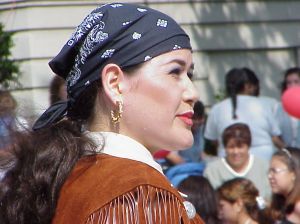10.05% of Hispanic Americans consider themselves lactose intolerant
Lactose Intolerant Hispanic Rates May Be Significantly Lower Than Previously Believed
New study sheds light on self-reported prevalence rates
Prevalence of lactose intolerance may be far lower than previously estimated, according to a study in the latest issue of Nutrition Today.(1)The study, which uses data from a national sample of three ethnic groups, reveals that the overall prevalence rate of self-reported lactose intolerance is 12 percent – with 7.72 percent of European Americans, 10.05 percent of Hispanic Americans and 19.5 percent of African Americans who consider themselves lactose intolerant.
These new findings indicate that previous estimates of lactose intolerance incidence – based on the incidence of lactose maldigestion – may be overestimated by wide margins. Previous studies have found lactose maldigestion, or low lactase activity in the gut, to occur in approximately 15 percent of European Americans, 50 percent of Mexican Americans and 80 percent of African Americans.(2,3,4) The new study shows that lactose intolerance, based on self-reported data, may actually occur far less frequently than presumed.
“There’s so much confusion surrounding lactose intolerance,” said Theresa Nicklas, DrPH, of the USDA/ARS Children’s Nutrition Research Center at Baylor College of Medicine and lead study author. “By getting a better handle on the true number of people who deal with this condition every day, the nutrition community can be better equipped to educate and provide dietary guidance for Americans, including strategies to help meet dairy food recommendations for those who self-report lactose intolerance.”
Since increasing daily consumption of dairy can be an effective strategy for ensuring adequate intake of shortfall nutrients (such as calcium, magnesium and potassium),(5) those who do experience symptoms of lactose intolerance should know there are several practical solutions that can allow for consumption of milk and milk products. In fact, according to a recent study in the Journal of Sensory Studies, adults who identified themselves as lactose intolerant reported a higher liking of lactose-free cow’s milk compared to non-dairy, soy-based substitute beverage.(6)
“Those with lactose intolerance are often relieved to know they can still enjoy the great taste and health benefits of dairy if they follow certain strategies,” said Orsolya Palacios, PhD, RD, and lead author of the study. “The symptoms of lactose intolerance vary greatly for each individual, and there are options in the dairy case that allow almost everyone to take advantage of the health benefits provided by the recommended three daily servings of dairy foods.”
Recommended Solutions for Incorporating Dairy
Several health authorities have addressed ways that those with lactose intolerance can benefit from dairy’s unique nutrient package of nine essential nutrients including calcium, potassium, magnesium and vitamin A, identified as “nutrients of concern” by the current Dietary Guidelines for Americans.(7) The Dietary Guidelines encourages people with lactose intolerance to try lower-lactose dairy food options to ensure they get the essential nutrients found in dairy. In a supplement to the October issue of the Journal of the National Medical Association (JNMA), the National Medical Association states that dairy milk alone provides a key package of essential nutrients, and that African Americans should use dietary strategies to increase the amount of dairy foods they consume. And in a 2006 report, the American Academy of Pediatrics (AAP) recommends children with lactose intolerance still consume dairy foods to help meet calcium, vitamin D, protein and other nutrient needs essential for bone health and overall growth. The report cautions that lactose intolerance should not require avoidance of dairy foods.(8)
The National Dairy Council has identified some strategies to help people with lactose intolerance enjoy the taste and nutrition of dairy:
- The good news is lactose-free milk is regular milk, just without the lactose.
- It provides the same unique package of nine essential nutrients as found in the equivalent form of regular milk (reduced-fat, fat-free etc.) – calcium, potassium, phosphorus, protein, vitamins A, D and B12, riboflavin and niacin (niacin equivalents).
- Try drinking small amounts of milk with meals.
- Consuming milk with other foods or a meal can make it easier to digest, so try milk on cereal, in smoothies or licuados, and enjoy a glass of milk with lunch or dinner.
- Try cooking with milk.
- Make oatmeal with milk instead of water and add milk to soups, sauces, casseroles, etc.
- Try eating yogurt.
- Yogurts that contain live and active cultures can make it easier for the digestive system to digest lactose.
- Try aged cheeses.
- Aged cheeses like Swiss, Parmesan, Gouda, Colby, provolone, Cheddar, Edam, Fontina, Gruyere, Muenster and Monterey Jack have very little lactose.
For more information, visit www.nationaldairycouncil.org, and get the latest dairy and nutrition news from NDC’s blog,www.thedairyreport.com.
National Dairy Council® (NDC) is the nutrition research, education and communications arm of Dairy Management Inc(TM). On behalf of U.S. dairy farmers, NDC provides science-based nutrition information to, and in collaboration with, a variety of stakeholders committed to fostering a healthier society, including health professionals, educators, school nutrition directors, academia, industry, consumers and media. Established in 1915, NDC comprises a staff of nutrition science researchers, registered dietitians and communications experts dedicated to educating the public on the health benefits of consuming milk and milk products throughout a person’s lifespan.
In addition, NDC funds independent research to aid in the ongoing discovery of information about dairy foods’ important role in a healthy lifestyle. This research provides insights to industry for new dairy product innovation. In partnership with its network of state and regional dairy councils, NDC disseminates nutrition programs, materials and research to support government recommendations for improved nutrition for Americans, including consumption of at least three servings of nutrient-rich low-fat or fat-free milk and milk products a day.
(1) Nicklas TA, Qu H, Hughes SO. Prevalence of self-reported lactose intolerance in a multi-ethnic sample of adults. Nutrition Today 2009; 44(5):186-187
(2) Jarvis JK, Miller GD. Overcoming the barrier of lactose intolerance to reduce health disparities. J Natl Med Assoc 2002; 94:55-56
(3) Sabi T. Hypolactasia and lactase persistence; historical review and terminology. Scandinavian Journal of Gastroenterology. Supplement 1994; 202:1-6
(4) Scrimshaw NS, Murray ED. Prevalence of lactose maldigestion. Am J Clin Nutr 1988; 48:1086-1098
(5) Nicklas TA, O’Neil CE, Fulgoni III VL. The role of dairy in meeting the recommendations for shortfall nutrients in the American diet. J Am Coll Nutr 2009; 28:1S-9S
(6) Palacios OM, Badran J, Drake MA, Reisner M, Moskowitz HR. Consumer acceptance of cow’s milk versus soy beverages; impact of ethnicity, lactose tolerance and sensory performance segmentation. Journal of Sensory Studies 2009; 24 (5): 731-748(18)
(7) U.S. Department of Health and Human Services and U.S. Department of Agriculture. Dietary Guidelines for Americans, 2005. 6th Edition, Washington, DC: U.S. Government Printing Office, January 2005.
(8) American Academy of Pediatrics, Lactose intolerance in infants, children, and adolescents. Pediatrics. 2006; 118 (3):1279-1286
For more information:
NDC Media Hotline
312-240-2880
ndc@dairyinfo.com
SOURCE National Dairy Council













